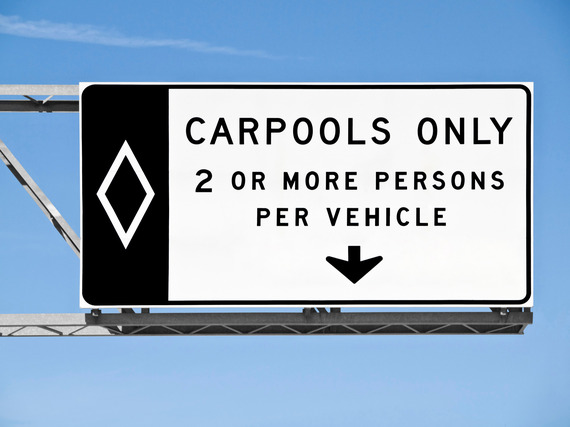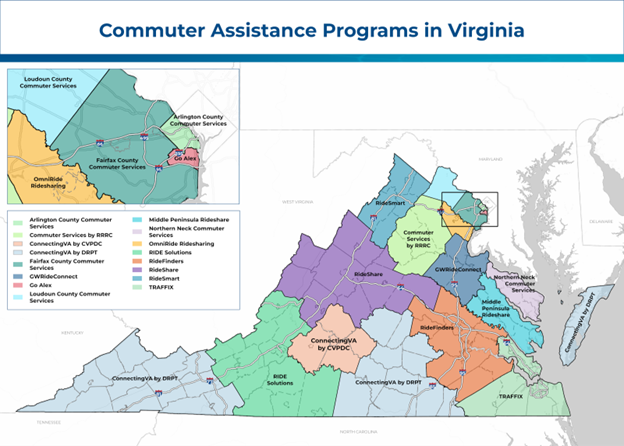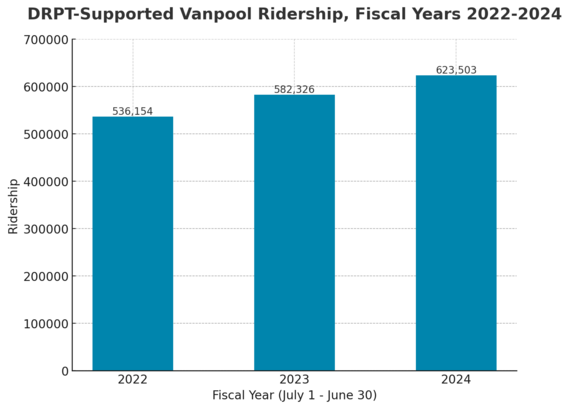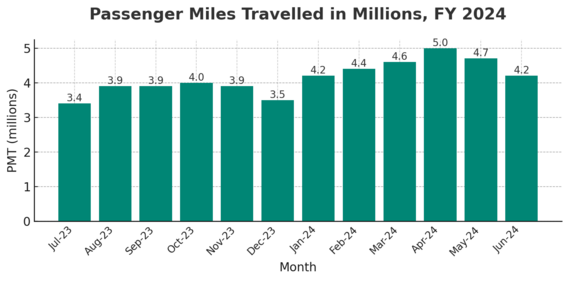|
|
Welcome to the Department of Rail and Public Transportation’s Data Stories, and thank you for signing up! This monthly series aims to find the narrative in data DRPT collects and uses, highlighting Virginia’s rail and transit community. This month, DRPT delves into the world of vanpooling and Virginia’s Commuter Assistance Programs.
 One of the most effective ways to reduce congestion, ease the cost of commuting, lower greenhouse gas emissions, and have a more relaxed commute is simple: drive with multiple other people. Carpools can range from informal commutes, such as asking a coworker for a ride to work, to vanpools organized by companies or regional transportation demand management entities. DRPT’s Commuter Programs activities supports both. DRPT collects performance metrics from Vanpools supported by DRPT, and with vanpooling having over 600,000 riders and nearly 50 million passenger miles travelled in Fiscal Year 2024, these programs make a big impact across Virginia.
|
|
Defining Vanpooling
 A vanpool is a group of commuters who share a ride to and from work in a 7 to 15 passenger vehicle. The group leases or rents the vehicle from a vanpool company. The vanpool company provides insurance, vehicle maintenance and repairs, and a backup vehicle if the leased vehicle becomes unavailable. The vanpool group splits the monthly cost of leasing the vehicle plus fuel and parking expenses. The vanpool group decides the pick-up and drop-off locations which are typically an area near the commuters’ homes, often a park-and-ride lot or local meeting place, and travels to one or more work sites in close proximity. One or more people in the group volunteer to drive the vanpool. Commuters may receive a subsidy from their employer if their employer offers a commuter/vanpool benefit as either a direct benefit or a pre-tax set aside.
An important note: vanpools in this case refer to the organized and managed vanpools with a set roster of riders. Informal commutes such as the phenomenon of “slugging” or two coworkers electing to carpool to work together are not included.
To support Virginia’s vanpool network, local or regional government organizations (such as a public transit provider or planning district commission), with assistance from DRPT, have set up local and regional commuter assistance programs, which work with commuters to coordinate setting up a vanpool and finding riders. There are 16 commuter assistance programs in Virginia, serving all parts of the Commonwealth and ranging from single-city commuter programs to multi-city and county commuter areas. The map below identifies and locates Virginia’s commuter assistance programs and their service areas:

|
|
DRPT and the Commuter Assistance Programs
So, how does the Department of Rail and Public Transportation support commuter assistance programs and vanpooling? Through the aptly named Commuter Assistance Program! The Commuter Assistance Program (CAP) is a statewide grant program that provides operating and project assistance funding to support the establishment and operation of vanpools, as well as for projects, marketing, and incentivizing the use of vanpools. These grants reduce the cost burden on vanpoolers or on the regional entities that coordinate vanpools. DRPT’s CAP grant recipients report vanpool performance data to DRPT.
|
|
|
The Data
DRPT-supported commuter assistance programs move hundreds of thousands of people every year, removing cars from Virginia’s most congested highways, while saving riders money by splitting the cost of commuting between a larger group and reducing greenhouse gas emissions. Overall vanpool ridership continues to grow, with over 623 thousand vanpool riders in FY 2024. The chart below visualizes this growth in Vanpool ridership:
 Passenger miles travelled is the total, cumulative amount every passenger travels. For example, if one vanpool drove five people 50 miles, that is 250 PMT. This illustrates the impact and benefit of carpooling and vanpooling – by combining trips into one vehicle, millions of miles travelled are taken off Virginia’s roads and highways. This eases congestion, reduces travel time, saves gas, and reduces the amount of road maintenance needed. The table below shows the month-to-month total PMT for FY 2024:
 In total, there were just under 50 million Passenger Miles Travelled using vanpools in FY 2024, with month-to-month fluctuations attributable to holidays and vacation season. For comparison, in FY 2023, the first fiscal year PMT tracking began, DRPT’s CAP programs supported 42.4 million PMT. That translates to about a 17% increase, year over year.
|
|
How do you join a vanpool?
Vanpools can be set up or joined by using DRPT’s ConnectingVA app or website, matching individuals who work nearby each other or by employers looking to make their employees’ commute easier and more affordable. Virginians can contract their area's commuter program such as RideSmart in the Northern Shenandoah Valley or Traffix in Hampton Roads. Additionally, employees of the federal government who work in the Northern Virginia area are eligible for the Transit Benefits Plan. State and local governments, and many private sector employers also offer employees a commuter benefit for commuting by transit or vanpool.
 DRPT’s ConnectingVA program, Commuter Assistance Program grant program, and Virginia’s local and regional commuter assistance programs create positive impacts on the Commonwealth by supporting programs that improve access to reliable transportation. Vanpools help commuters save money by splitting the cost of commuting, easing congestion on Virginia’s busiest highways by combining what would have been multiple single occupancy vehicles into one van, and reducing emissions. DRPT’s Commuter Programs are an extremely cost-effective way to benefit the Commonwealth using limited taxpayer dollars.
|
|
 DRPT’s mission is to connect and improve the quality of life for all Virginians with innovative transportation solutions. The SYIP turns that mission into action, by funding rail and public transportation priorities. With funding from the SYIP, transit agencies across Virginia provide over 10 million trips per month on buses, light rails, and subways. Freight rail programs divert around 14 million trucks from Virginia’s roads and attract hundreds of new jobs. Having trouble viewing this email? View it as a Web page.
Follow Us
|
|
|
|
|